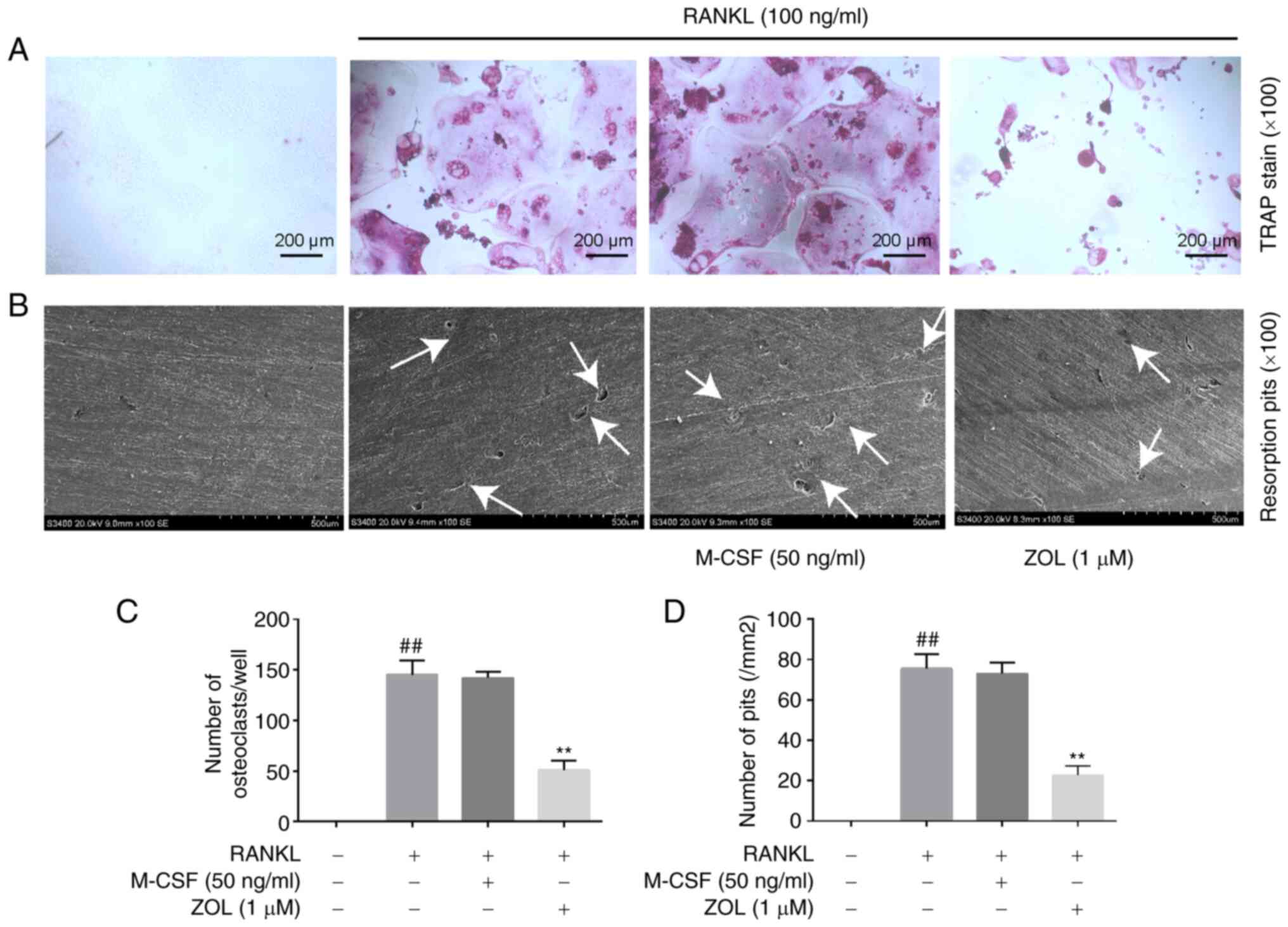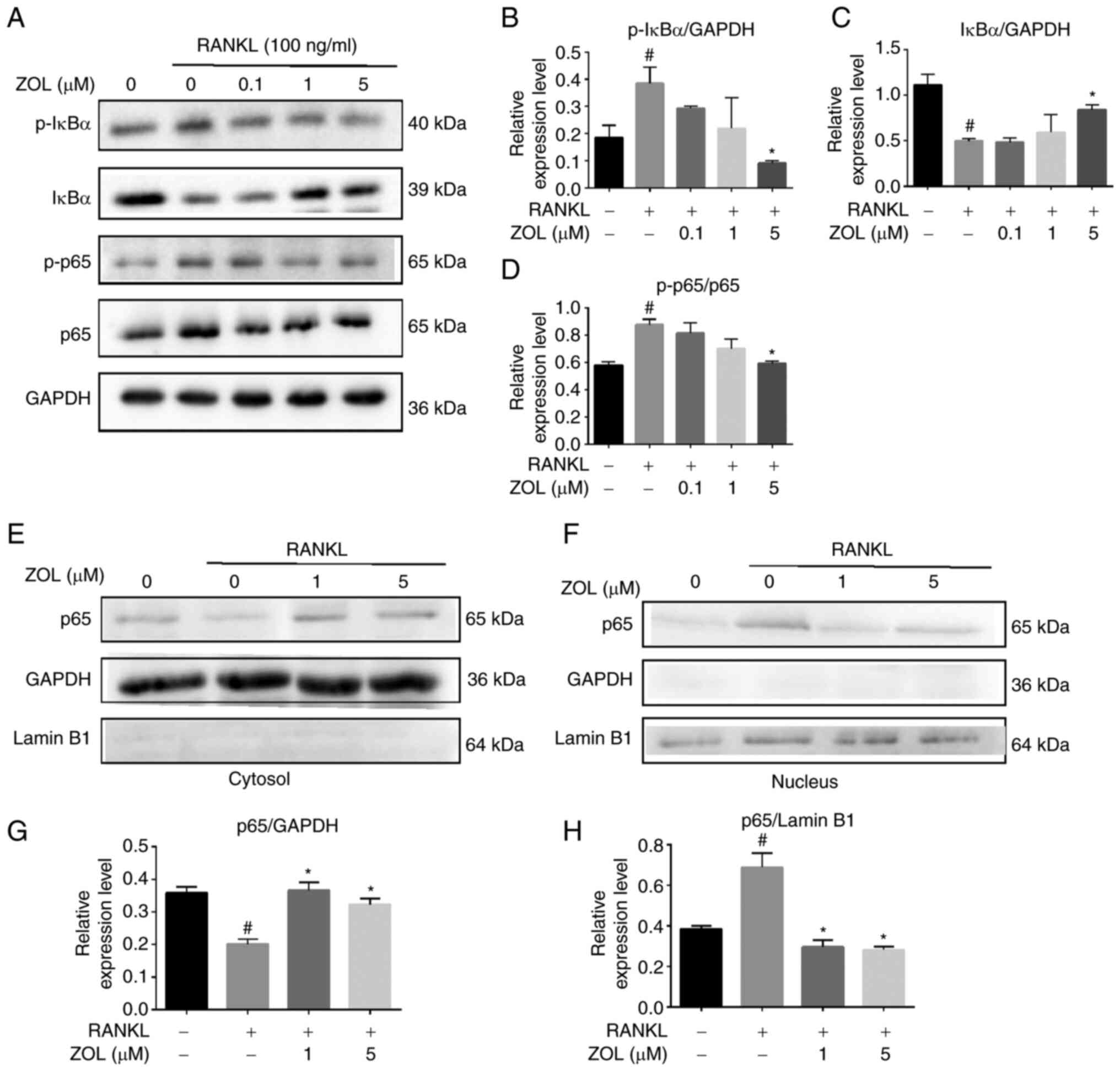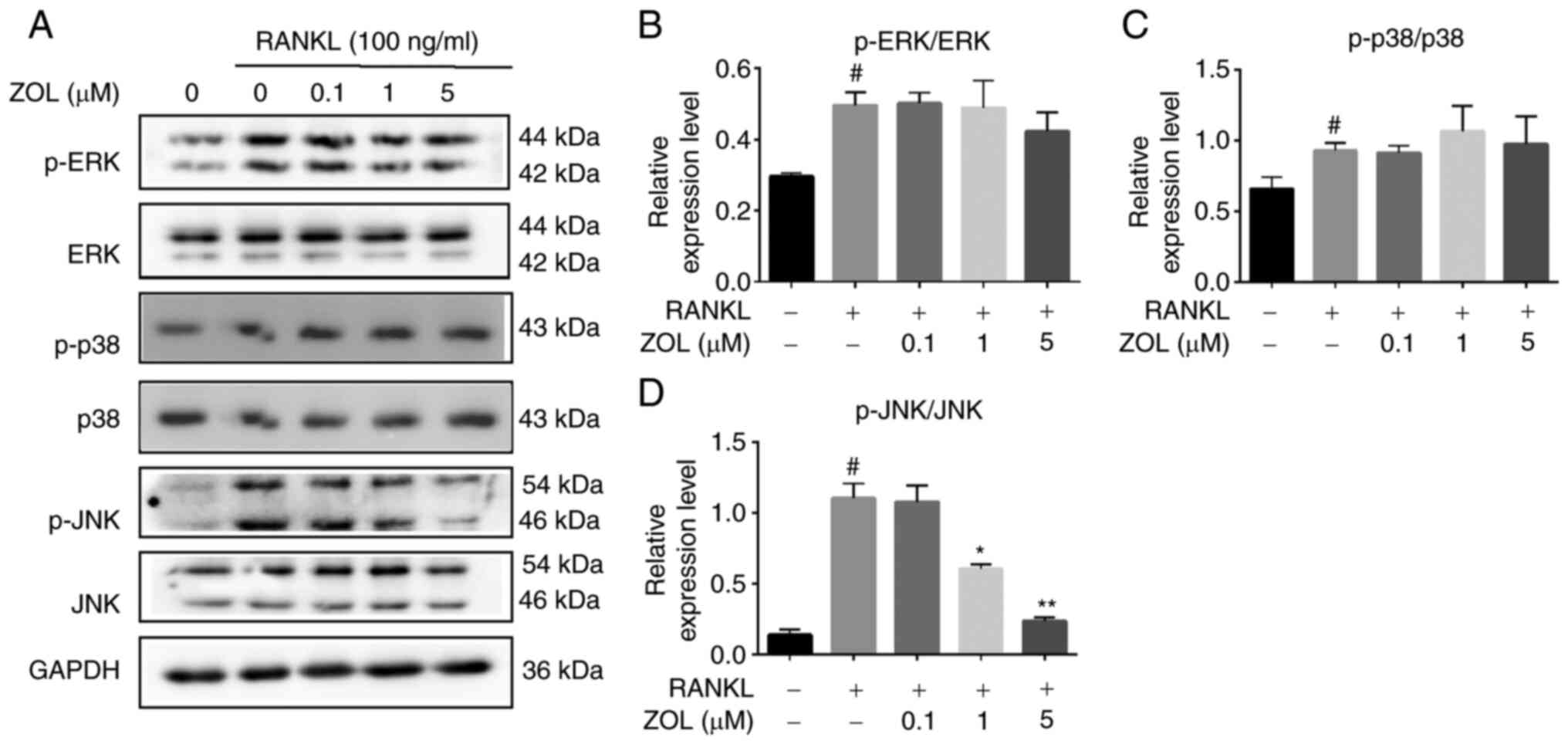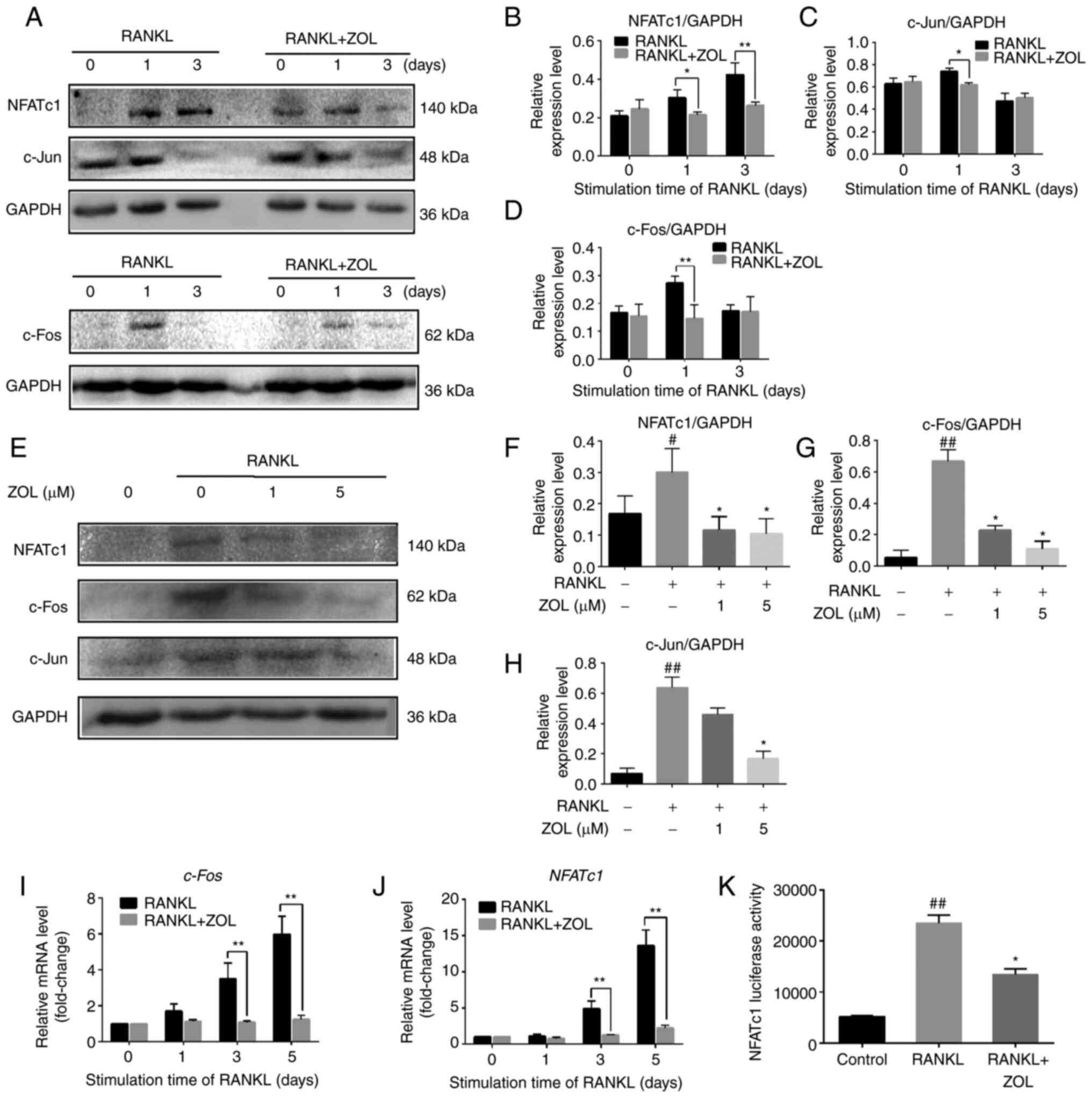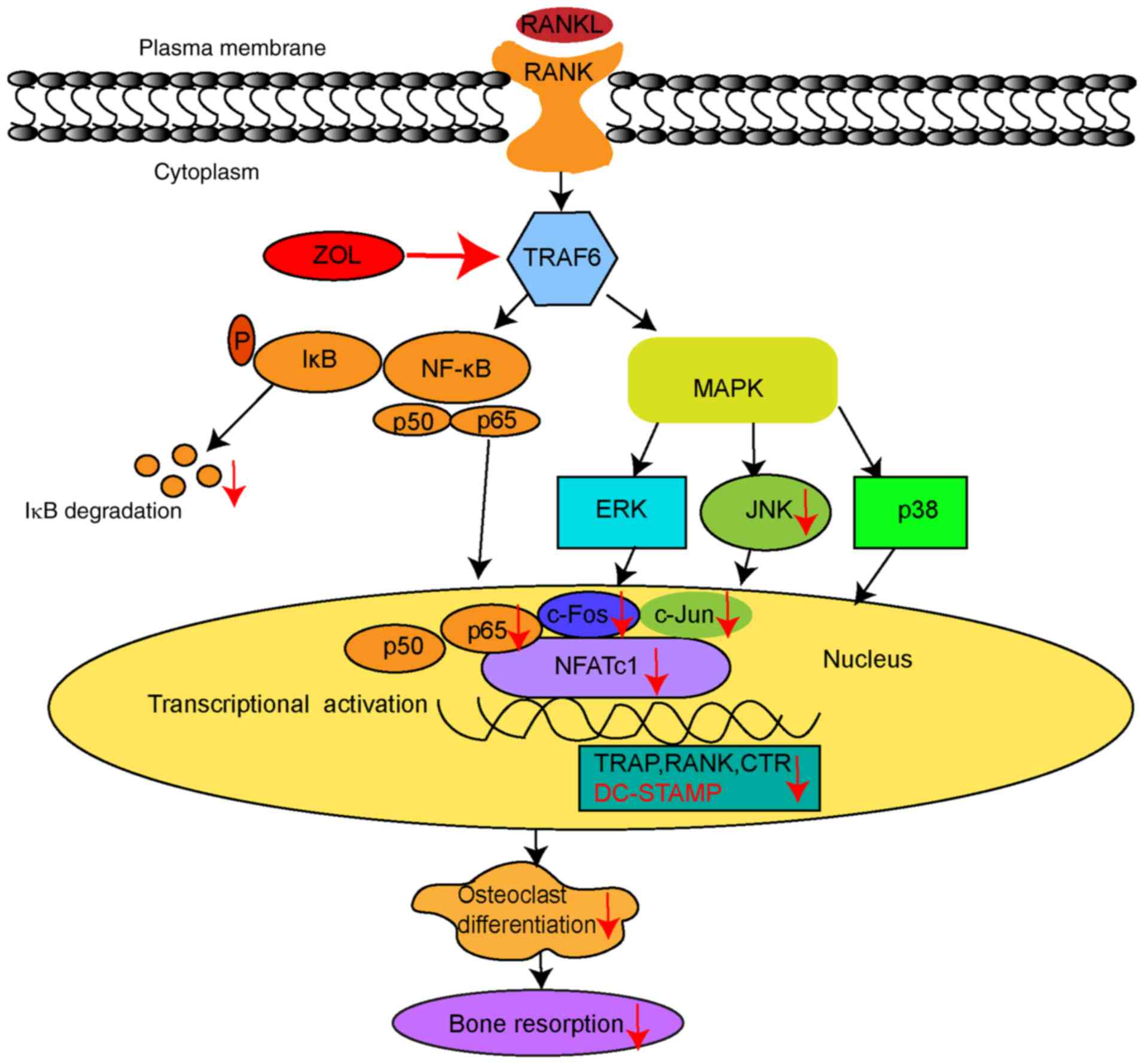|
1
|
Li DZ, Zhang QX, Dong XX, Li HD and Ma X:
Treatment with hydrogen molecules prevents RANKL-induced osteoclast
differentiation associated with inhibition of ROS formation and
inactivation of MAPK, AKT and NF-kappa B pathways in murine
RAW264.7 cells. J Bone Miner Metab. 32:494–504. 2014. View Article : Google Scholar : PubMed/NCBI
|
|
2
|
Cosman F, de Beur SJ, LeBoff MS, Lewiecki
EM, Tanner B, Randall S and Lindsay R; National Osteoporosis
Foundation, : Clinician's guide to prevention and treatment of
osteoporosis. Osteoporos Int. 25:2359–2381. 2014. View Article : Google Scholar : PubMed/NCBI
|
|
3
|
Yang JH, Li B, Wu Q, Lv JG and Nie HY:
Echinocystic acid inhibits RANKL-induced osteoclastogenesis by
regulating NF-κB and ERK signaling pathways. Biochem Biophys Res
Commun. 477:673–677. 2016. View Article : Google Scholar : PubMed/NCBI
|
|
4
|
Madel MB, Ibáñez L, Wakkach A, de Vries
TJ, Teti A, Apparailly F and Blin-Wakkach C: Immune function and
diversity of osteoclasts in normal and pathological conditions.
Front Immunol. 10:14082019. View Article : Google Scholar : PubMed/NCBI
|
|
5
|
Islam R, Bae HS, Yoon WJ, Woo KM, Baek JH,
Kim HH, Uchida T and Ryoo HM: Pin1 regulates osteoclast fusion
through suppression of the master regulator of cell fusion
DC-STAMP. J Cell Physiol. 229:2166–2174. 2014. View Article : Google Scholar : PubMed/NCBI
|
|
6
|
Lee JW, Kobayashi Y, Nakamichi Y, Udagawa
N, Takahashi N, Im NK, Seo HJ, Jeon WB, Yonezawa T, Cha BY and Woo
JT: Alisol-B, a novel phyto-steroid, suppresses the RANKL-induced
osteoclast formation and prevents bone loss in mice. Biochem
Pharmacol. 80:352–361. 2010. View Article : Google Scholar : PubMed/NCBI
|
|
7
|
Nakashima T and Takayanagi H: New
regulation mechanisms of osteoclast differentiation. Ann NY Acad
Sci. 1240:E13–E18. 2011. View Article : Google Scholar : PubMed/NCBI
|
|
8
|
He Y, Zhang Q, Shen Y, Chen X, Zhou F and
Peng D: Schisantherin A suppresses osteoclast formation and wear
particle-induced osteolysis via modulating RANKL signaling
pathways. Biochem Biophys Res Commun. 449:344–350. 2014. View Article : Google Scholar : PubMed/NCBI
|
|
9
|
Yen ML, Hsu PN, Liao HJ, Lee BH and Tsai
HF: TRAF-6 dependent signaling pathway is essential for TNF-related
apoptosis-inducing ligand (TRAIL) induces osteoclast
differentiation. PLoS One. 7:e380482012. View Article : Google Scholar : PubMed/NCBI
|
|
10
|
Léotoing L, Wauquier F, Guicheux J,
Miot-Noirault E, Wittrant Y and Coxam V: The polyphenol fisetin
protects bone by repressing NF-κB and MKP-1-dependent signaling
pathways in osteoclasts. PLoS One. 8:e683882013. View Article : Google Scholar : PubMed/NCBI
|
|
11
|
Cheng B, Li J, Du J, Lv X, Weng L and Ling
C: Ginsenoside Rb1 inhibits osteoclastogenesis by modulating NF-κB
and MAPKs pathways. Food Chem Toxicol. 50:1610–1615. 2012.
View Article : Google Scholar : PubMed/NCBI
|
|
12
|
Soysa NS, Alles N, Aoki K and Ohya K:
Osteoclast formation and differentiation: An overview. J Med Dent
Sci. 59:65–74. 2012.PubMed/NCBI
|
|
13
|
Lieben L: Bone: The concept of
RANKL-independent osteoclastogenesis refuted. Nat Rev Rheumatol.
12:6232016. View Article : Google Scholar : PubMed/NCBI
|
|
14
|
Cai XJ, Wang Z, Cao JW, Ni JJ, Xu YY, Yao
J, Xu H, Liu F and Yang GY: Anti-angiogenic and anti-tumor effects
of metronomic use of novel liposomal zoledronic acid depletes
tumor-associated macrophages in triple negative breast cancer.
Oncotarget. 8:84248–84257. 2017. View Article : Google Scholar : PubMed/NCBI
|
|
15
|
Endo Y, Kumamoto H, Nakamura M, Sugawara
S, Takano-Yamamoto T, Sasaki K and Takahashi T: Underlying
mechanisms and therapeutic strategies for bisphosphonate-related
osteonecrosis of the jaw (BRONJ). Biol Pharm Bull. 40:739–750.
2017. View Article : Google Scholar : PubMed/NCBI
|
|
16
|
Elsayed R, Abraham P, Awad ME, Kurago Z,
Baladhandayutham B, Whitford GM, Pashley DH, McKenna CE and
Elsalanty ME: Removal of matrix-bound zoledronate prevents
post-extraction osteonecrosis of the jaw by rescuing osteoclast
function. Bone. 110:141–149. 2018. View Article : Google Scholar : PubMed/NCBI
|
|
17
|
Russell RG: Bisphosphonates: The first 40
years. Bone. 49:2–19. 2011. View Article : Google Scholar : PubMed/NCBI
|
|
18
|
Qiao H, Wang TY, Yu ZF, Han XG, Liu XQ,
Wang YG, Fan QM, Qin A and Tang TT: Structural simulation of
adenosine phosphate via plumbagin and zoledronic acid competitively
targets JNK/Erk to synergistically attenuate osteoclastogenesis in
a breast cancer model. Cell Death Dis. 7:e20942016. View Article : Google Scholar : PubMed/NCBI
|
|
19
|
Li X, Sun W, Li J, Wang M, Zhang H, Pei L,
Boyce BF, Wang Z and Xing L: Clomipramine causes osteoporosis by
promoting osteoclastogenesis via E3 ligase Itch, which is prevented
by zoledronic acid. Sci Rep. 7:413582017. View Article : Google Scholar : PubMed/NCBI
|
|
20
|
Li P, Yang H, Jia N, Jin X, Xu D and Shen
Y: Experimental study on inhibitory effect of zoledronic acid on
the action style of the osteoclast. Sheng Wu Yi Xue Gong Cheng Xue
Za Zhi. 34:78–82. 2017.(In Chinese). PubMed/NCBI
|
|
21
|
de Oliveira MA, Asahi DA, Silveira CAE,
Lima LAPA, Glick M and Gallottini M: The effects of zoledronic acid
and dexamethasone on osseointegration of endosseous implants:
Histological and histomorphometrical evaluation in rats. Clin Oral
Implants Res. 26:e17–e21. 2015. View Article : Google Scholar : PubMed/NCBI
|
|
22
|
Weber JBB, Camilotti RS, Jasper J,
Casagrande LCO and Maito FLDM: Effect of low-level laser therapy on
tissue repair after dental extraction in rats administered
zoledronic acid and dexamethasone. J Biomed Opt. 22:580012017.
View Article : Google Scholar : PubMed/NCBI
|
|
23
|
Allen MR, Chu TM and Ruggiero SL: Absence
of exposed bone following dental extraction in beagle dogs treated
with 9 months of high-dose zoledronic acid combined with
dexamethasone. J Oral Maxillofac Surg. 71:1017–1026. 2013.
View Article : Google Scholar : PubMed/NCBI
|
|
24
|
Subramanian G, Fritton JC, Iyer S and Quek
SY: Atypical dental implant failure with long-term bisphosphonate
treatment-akin to atypical fractures? Oral Surg Oral Med Oral
Pathol Oral Radiol. 114:e30–e35. 2012. View Article : Google Scholar : PubMed/NCBI
|
|
25
|
Qi M, Hu J, Li J, Li J, Dong W, Feng X and
Yu J: Effect of zoledronate acid treatment on osseointegration and
fixation of implants in autologous iliac bone grafts in
ovariectomized rabbits. Bone. 50:119–127. 2012. View Article : Google Scholar : PubMed/NCBI
|
|
26
|
Khosla S and Shane E: A crisis in the
treatment of osteoporosis. J Bone Miner Res. 31:1485–1487. 2016.
View Article : Google Scholar : PubMed/NCBI
|
|
27
|
Kim SC, Kim DH, Mogun H, Eddings W,
Polinski JM, Franklin JM and Solomon DH: Impact of the U.S. food
and drug administration's safety-related announcements on the use
of bisphosphonates after hip fracture. J Bone Miner Res.
31:1536–1540. 2016. View Article : Google Scholar : PubMed/NCBI
|
|
28
|
Nakagawa T, Ohta K, Uetsuki R, Kato H,
Naruse T, Murodumi H, Yokoyama S, Sakuma M, Ono S and Takechi M:
Zoledronate inhibits osteoclast differentiation via suppressing
vascular endothelial growth factor receptor 2 expression. Biochem
Genet. 58:473–489. 2020. View Article : Google Scholar : PubMed/NCBI
|
|
29
|
Dundar S, Yaman F, Gecor O, Cakmak O,
Kirtay M, Yildirim TT, Karaman T and Benlidayi ME: Effects of local
and systemic zoledronic acid application on titanium implant
osseointegration: An experimental study conducted on two surface
types. J Craniofac Surg. 28:935–938. 2017. View Article : Google Scholar : PubMed/NCBI
|
|
30
|
Chadha GK, Ahmadieh A, Kumar S and
Sedghizadeh PP: Osseointegration of dental implants and
osteonecrosis of the jaw in patients treated with bisphosphonate
therapy: A systematic review. J Oral Implantol. 39:510–520. 2013.
View Article : Google Scholar : PubMed/NCBI
|
|
31
|
Kim HJ, Kim HJ, Choi Y, Bae MK, Hwang DS,
Shin SH and Lee JY: Zoledronate enhances osteocyte-mediated
osteoclast differentiation by IL-6/RANKL axis. Int J Mol Sci.
2:14672019. View Article : Google Scholar
|
|
32
|
Huang XL, Huang LY, Cheng YT, Li F, Zhou
Q, Wu C, Shi QH, Guan ZZ, Liao J and Hong W: Zoledronic acid
inhibits osteoclast differentiation and function through the
regulation of NF-κB and JNK signalling pathways. Int J Mol Med.
44:582–592. 2019.PubMed/NCBI
|
|
33
|
Chen G, Huang L, Wu X, Liu X, Xu Q, Li F,
Dai M and Zhang B: Adiponectin inhibits osteoclastogenesis by
suppressing NF-κB and p38 signaling pathways. Biochem Biophys Res
Commun. 503:2075–2082. 2018. View Article : Google Scholar : PubMed/NCBI
|
|
34
|
Jiao Z, Xu W, Zheng J, Shen P, Qin A,
Zhang S and Yang C: Kaempferide prevents titanium particle induced
osteolysis by suppressing JNK activation during osteoclast
formation. Sci Rep. 7:166652017. View Article : Google Scholar : PubMed/NCBI
|
|
35
|
Livak KJ and Schmittgen TD: Analysis of
relative gene expression data using real-time quantitative PCR and
the 2(−Delta Delta C(T)) method. Methods. 25:402–408. 2001.
View Article : Google Scholar : PubMed/NCBI
|
|
36
|
Shibata K, Yoshimura Y, Kikuiri T,
Hasegawa T, Taniguchi Y, Deyama Y, Suzuki K and Iida J: Effect of
the release from mechanical stress on osteoclastogenesis in
RAW264.7 cells. Int J Mol Med. 28:73–79. 2011.PubMed/NCBI
|
|
37
|
Tsubaki M, Komai M, Itoh T, Imano M,
Sakamoto K, Shimaoka H, Takeda T, Ogawa N, Mashimo K, Fujiwara D,
et al: Nitrogen-containing bisphosphonates inhibit RANKL- and
M-CSF-induced osteoclast formation through the inhibition of ERK1/2
and Akt activation. J Biomed Sci. 21:102014. View Article : Google Scholar : PubMed/NCBI
|
|
38
|
Kang MR, Jo SA, Yoon YD, Park KH, Oh SJ,
Yun J, Lee CW, Nam KH, Kim Y, Han SB, et al: Agelasine D suppresses
RANKL-induced osteoclastogenesis via down-regulation of c-Fos,
NFATc1 and NF-κB. Mar Drugs. 12:5643–5656. 2014. View Article : Google Scholar : PubMed/NCBI
|
|
39
|
Kong X, Wu W, Yang Y, Wan H, Li X, Zhong
M, Zhao H, Su X, Jia S, Ju D and Lin N: Total saponin from anemone
flaccida Fr. Schmidt abrogates osteoclast differentiation and bone
resorption via the inhibition of RANKL-induced NF-κB, JNK and p38
MAPKs activation. J Transl Med. 13:912015. View Article : Google Scholar : PubMed/NCBI
|
|
40
|
Prideaux M, Findlay DM and Atkins GJ:
Osteocytes: The master cells in bone remodelling. Curr Opin
Pharmacol. 28:24–30. 2016. View Article : Google Scholar : PubMed/NCBI
|
|
41
|
Tseng HC, Kanayama K, Kaur K, Park SH,
Park S, Kozlowska A, Sun S, McKenna CE, Nishimura I and Jewett A:
Bisphosphonate-induced differential modulation of immune cell
function in gingiva and bone marrow in vivo: Role in
osteoclast-mediated NK cell activation. Oncotarget. 6:20002–20025.
2015. View Article : Google Scholar : PubMed/NCBI
|
|
42
|
Otero JE, Chen T, Zhang K and Abu-Amer Y:
Constitutively active canonical NF-κB pathway induces severe bone
loss in mice. PLoS One. 7:e386942012. View Article : Google Scholar : PubMed/NCBI
|
|
43
|
Kim HK, Kim MG and Leem KH: Osteogenic
activity of collagen peptide via ERK/MAPK pathway mediated boosting
of collagen synthesis and its therapeutic efficacy in osteoporotic
bone by back-scattered electron imaging and microarchitecture
analysis. Molecules. 18:15474–15489. 2013. View Article : Google Scholar : PubMed/NCBI
|
|
44
|
Sui X, Kong N, Ye L, Han W, Zhou J, Zhang
Q, He C and Pan H: p38 and JNK MAPK pathways control the balance of
apoptosis and autophagy in response to chemotherapeutic agents.
Cancer Lett. 344:174–179. 2014. View Article : Google Scholar : PubMed/NCBI
|
|
45
|
Zhai ZJ, Li HW, Liu GW, Qu XH, Tian B, Yan
W, Lin Z, Tang TT, Qin A and Dai KR: Andrographolide suppresses
RANKL-induced osteoclastogenesis in vitro and prevents inflammatory
bone loss in vivo. Br J Pharmacol. 171:663–675. 2014. View Article : Google Scholar : PubMed/NCBI
|
|
46
|
Huh JE, Jung IT, Choi J, Baek YH, Lee JD,
Park DS and Choi DY: The natural flavonoid galangin inhibits
osteoclastic bone destruction and osteoclastogenesis by suppressing
NF-κB in collagen-induced arthritis and bone marrow-derived
macrophages. Eur J Pharmacol. 698:57–66. 2013. View Article : Google Scholar : PubMed/NCBI
|
|
47
|
Yamanaka Y, Clohisy JC, Ito H, Matsuno T
and Abu-Amer Y: Blockade of JNK and NFAT pathways attenuates
orthopedic particle-stimulated osteoclastogenesis of human
osteoclast precursors and murine calvarial osteolysis. J Orthop
Res. 31:67–72. 2013. View Article : Google Scholar : PubMed/NCBI
|
|
48
|
Park JH, Lee NK and Lee SY: Current
understanding of RANK signaling in osteoclast differentiation and
maturation. Mol Cells. 40:706–713. 2017.PubMed/NCBI
|
|
49
|
Liu X, Qu X, Wu C, Zhai Z, Tian B, Li H,
Ouyang Z, Xu X, Wang W, Fan Q, et al: The effect of enoxacin on
osteoclastogenesis and reduction of titanium particle-induced
osteolysis via suppression of JNK signaling pathway. Biomaterials.
35:5721–5730. 2014. View Article : Google Scholar : PubMed/NCBI
|
|
50
|
Zhao Q, Wang X, Liu Y, He A and Jia R:
NFATc1: Functions in osteoclasts. Int J Biochem Cell Biol.
42:576–579. 2010. View Article : Google Scholar : PubMed/NCBI
|
|
51
|
Lee JH, Jin H, Shim HE, Kim HN, Ha H and
Lee ZH: Epigallocatechin-3-gallate inhibits osteoclastogenesis by
down-regulating c-Fos expression and suppressing the nuclear
factor-kappaB signal. Mol Pharmacol. 77:17–25. 2010. View Article : Google Scholar : PubMed/NCBI
|
|
52
|
Zhang C, Dou CE, Xu J and Dong S:
DC-STAMP, the key fusion-mediating molecule in osteoclastogenesis.
J Cell Physiol. 229:1330–1335. 2014. View Article : Google Scholar : PubMed/NCBI
|
|
53
|
Chiu YH, Mensah KA, Schwarz EM, Ju Y,
Takahata M, Feng C, McMahon LA, Hicks DG, Panepento B, Keng PC and
Ritchlin CT: Regulation of human osteoclast development by
dendritic cell-specific transmembrane protein (DC-STAMP). J Bone
Miner Res. 27:79–92. 2012. View Article : Google Scholar : PubMed/NCBI
|
|
54
|
Zeng XZ, He LG, Wang S, Wang K, Zhang YY,
Tao L, Li XJ and Liu SW: Aconine inhibits RANKL-induced osteoclast
differentiation in RAW264.7 cells by suppressing NF-κB and NFATc1
activation and DC-STAMP expression. Acta Pharmacol Sin. 37:255–263.
2016. View Article : Google Scholar : PubMed/NCBI
|
|
55
|
Kimachi K, Kajiya H, Nakayama S, Ikebe T
and Okabe K: Zoledronic acid inhibits RANK expression and migration
of osteoclast precursors during osteoclastogenesis. Naunyn
Schmiedebergs Arch Pharmacol. 383:297–308. 2011. View Article : Google Scholar : PubMed/NCBI
|
|
56
|
Lee H, Jin Y, Roh M, Tsacogianis TN, Park
S, Choi NK and Kim SC: Risk of cataract surgery and age-related
macular degeneration after initiation of denosumab vs zoledronic
acid for osteoporosis: A multi-database cohort study. Drugs Aging.
37:311–320. 2020. View Article : Google Scholar : PubMed/NCBI
|
|
57
|
Kondo H, Okimoto N, Yoshioka T, Akahoshi
S, Fuse Y, Ogawa T, Okazaki Y, Katae Y, Tsukamoto M, Yamanaka Y, et
al: Zoledronic acid sequential therapy could avoid disadvantages
due to the discontinuation of less than 3-year denosumab treatment.
J Bone Miner Metab. 38:894–902. 2020. View Article : Google Scholar : PubMed/NCBI
|
|
58
|
Mori T, Crandall CJ, Fujii T and Ganz DA:
Cost-effectiveness of zoledronic acid compared with sequential
denosumab/alendronate for older osteoporotic women in Japan. Arch
Osteoporos. 16:1132021. View Article : Google Scholar : PubMed/NCBI
|
|
59
|
Ikesue H, Mouri M, Tomita H, Hirabatake M,
Ikemura M, Muroi N, Yamamoto S, Takenobu T, Tomii K, Kawakita M, et
al: Associated characteristics and treatment outcomes of
medication-related osteonecrosis of the jaw in patients receiving
denosumab or zoledronic acid for bone metastases. Support Care
Cancer. 29:4763–4772. 2021. View Article : Google Scholar : PubMed/NCBI
|
|
60
|
Ikesue H, Doi K, Morimoto M, Hirabatake M,
Muroi N, Yamamoto S, Takenobu T and Hashida T: Switching from
zoledronic acid to denosumab increases the risk for developing
medication-related osteonecrosis of the jaw in patients with bone
metastases. Cancer Chemother Pharmacol. 87:871–877. 2021.
View Article : Google Scholar : PubMed/NCBI
|
|
61
|
Chen C, Li R, Yang T, Ma L, Zhou S, Li M,
Zhou Y and Cui Y: Denosumab versus zoledronic acid in the
prevention of skeletal-related events in vulnerable cancer
patients: A meta-analysis of randomized, controlled trials. Clin
Ther. 42:1494–1507.e1. 2020. View Article : Google Scholar : PubMed/NCBI
|
|
62
|
Yang G, Singh S, Chen Y, Hamadeh IS,
Langaee T, McDonough CW, Holliday LS, Lamba JK, Moreb JS, Katz J
and Gong Y: Pharmacogenomics of osteonecrosis of the jaw. Bone.
124:75–82. 2019. View Article : Google Scholar : PubMed/NCBI
|
|
63
|
Fliefel RM, Entekhabi SA, Ehrenfeld M and
Otto S: Geranylgeraniol (GGOH) as a mevalonate pathway activator in
the rescue of bone cells treated with zoledronic acid: An in vitro
study. Stem Cells Int. 2019:43513272019. View Article : Google Scholar : PubMed/NCBI
|
|
64
|
Nakagawa T, Ohta K, Kubozono K, Ishida Y,
Naruse T, Takechi M and Kamata N: Zoledronate inhibits receptor
activator of nuclear factor kappa-B ligand-induced osteoclast
differentiation via suppression of expression of nuclear factor of
activated T-cell c1 and carbonic anhydrase 2. Arch Oral Biol.
60:557–565. 2015. View Article : Google Scholar : PubMed/NCBI
|
|
65
|
Cui P, Liu H, Sun J, Amizuka N, Sun Q and
Li M: Zoledronate promotes bone formation by blocking
osteocyte-osteoblast communication during bone defect healing.
Histol Histopathol. 33:89–99. 2018.PubMed/NCBI
|
|
66
|
Zhang J, Park J, Lee JW, Kwon YD and Kim
EC: Bisphosphonates hinder osteoblastic/osteoclastic
differentiation in the maxillary sinus mucosa-derived stem cells.
Clin Oral Investig. 22:1933–1943. 2018. View Article : Google Scholar : PubMed/NCBI
|
|
67
|
Pan B, Farrugia AN, To LB, Findlay DM,
Green J, Lynch K and Zannettino AC: The nitrogen-containing
bisphosphonate, zoledronic acid, influences RANKL expression in
human osteoblast-like cells by activating TNF-alpha converting
enzyme (TACE). J Bone Miner Res. 19:147–154. 2004. View Article : Google Scholar : PubMed/NCBI
|
|
68
|
Cheng YT, Liao J, Zhou Q, Huo H, Zellmer
L, Tang ZL, Ma H, Hong W and Liao DJ: Zoledronic acid modulates
osteoclast apoptosis through activation of the NF-κB signaling
pathway in ovariectomized rats. Exp Biol Med (Maywood).
246:1727–1739. 2021. View Article : Google Scholar : PubMed/NCBI
|















